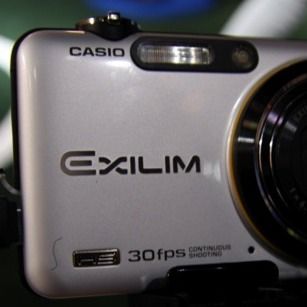When Casio launched its EX-F1 and EX-FH20 in 2008, the press went wild. The EX-F1's capability of being able to capture shots at up to 60 frames per second promised to change the way we take photographs. Then we saw the size. Fast shooting was going to have to be for those who didn't mind carrying some weight.
Our quick take
If as we suspect the camera's capabilities will follow in the same vein as the EX-FH20, then what you'll have here is a camera that allows you to have most of the benefits of the FH20, albeit without the 20x optical zoom, in a compact device.
Why would you want this? Well it takes out the niche element of seeing your golf stroke and makes the technology something that allows you to be even more blasé with your digital photography than ever before. Why try and attempt to capture the moment with a single photo and then probably miss it, when a single click of the shutter means you can blanket cover the shot and blast off 30 shots in one hit.
If the picture quality in the final model matches up to the performance on the show floor, this has the potential to change the way you take photographs.
The Casio EX-FC100 is due out later this year. No UK price has been set, however it is expected to cost around $399 in the US.

Casio EX-FC100 digital camera - First Look
| FOR | AGAINST |
|---|---|
|
|
A year on Casio has launched a compact camera version: the EX-FC100. So will it be any good? We managed to get a hands-on with the new camera at this year's CES in Las Vegas.
On the surface the EX-FC100 looks the same as any other compact camera from Casio. It sports a 2.7-inch screen, a 5x zoom and 9-megapixel resolution sensor.
There are slightly more buttons than you would perhaps expect to find on a compact camera, but on the whole the layout is fairly standard. There are buttons for working your way through the menu system, buttons for playing back images or video and a toggle wheel for selecting video or still image capture.
On the top above the screen is a button simply labelled "Slow" and this rather cleverly allows you to slow down the action as it appears on the screen so you can see what's happening real time but slower.
The example Casio gave us was one where you are about to take a picture of someone blowing out some candles on a birthday cake. You know you are about to take the picture so you "Slow" down the action, Matrix style, and then when they eventually do appear on the screen you can grab the picture at the right moment as if you've magically slowed time.
We tried it with some dancing cheerleaders put on by Casio at the booth and have to say the results seemed pretty impressive - the camera's capabilities not the cheerleaders of course, although they were very good too - ahem.
Back to the camera and the clear selling point here is that you can capture up to 30 frames per second in still mode at 6-megapixels or an impressive 1000 frames per second 720p HD movies all at the press of a button.
To access and harness that photo power, you get the same menu interface, no doubt tweaked slightly to cope with the new camera, as you did with the company's FH20 and EX1 models we've already seen. Without the previous model to hand when we were on the show floor, it does look to have been simplified further, as you would expect, just as the FH20 interface had been over the first stab, the EX1.
Switching between different shooting modes was easy, however the video mode still suffers the same fate as seen previously, in that the faster you go the smaller the video you record becomes.
Unfortunately we weren't able to take away any shots we took and therefore look at them more closely full screen - those cheerleaders were stunning though - so it would be unfair to rate the camera's picture quality, however in use snapping and reviewing images on the camera's memory card that was locked into the camera (security not feature) was fast to respond and the images (although they always do) did look good on the back of the screen.
To recap
This has the potential to change the way you take photographs
